BMP5006 Financial Management Presentation: ABC of Rock Widget Ltd
VerifiedAdded on 2023/06/04
|19
|2699
|317
Presentation
AI Summary
This presentation delves into Activity Based Costing (ABC), a financial management technique that allocates costs to activities rather than products or services, providing a more accurate allocation of resources and administrative costs. It compares ABC with traditional costing systems, highlighting the importance of accurate production cost calculation for decision-making. The presentation analyzes the application of ABC within Rock Widget Ltd, including resources, resource drivers, activities, activity drivers, and cost objects. It also discusses the advantages and disadvantages of ABC, the use of traditional costing techniques, and why ABC might be preferred. The presentation outlines the steps involved in implementing an ABC system, including identifying activities, determining activity cost drivers, and calculating activity cost driver rates to improve overhead allocation. It emphasizes how ABC offers a more precise picture of cost behavior, leading to better financial decisions.
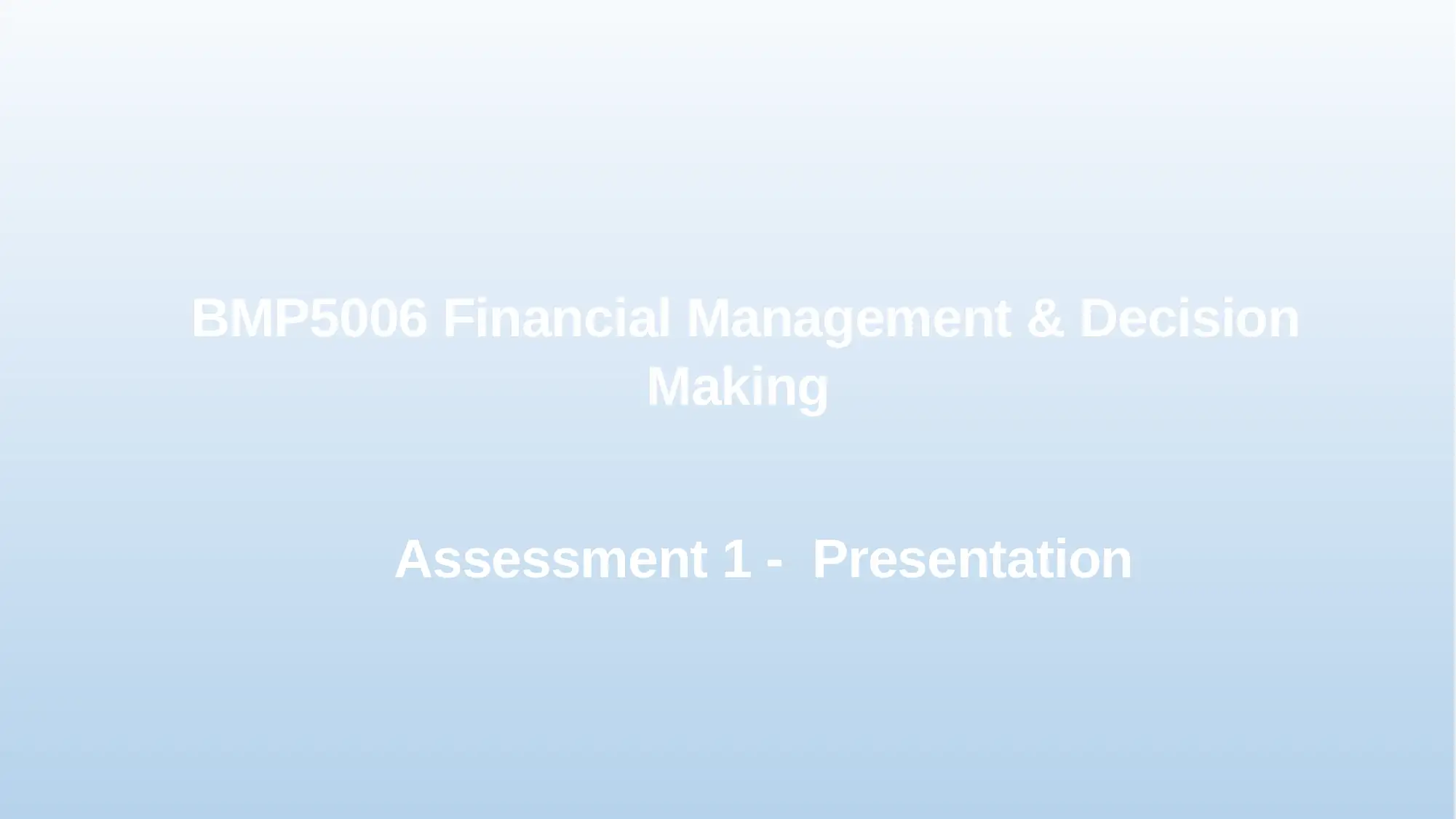
BMP5006 Financial Management & Decision
Making
Assessment 1 - Presentation
Making
Assessment 1 - Presentation
Paraphrase This Document
Need a fresh take? Get an instant paraphrase of this document with our AI Paraphraser
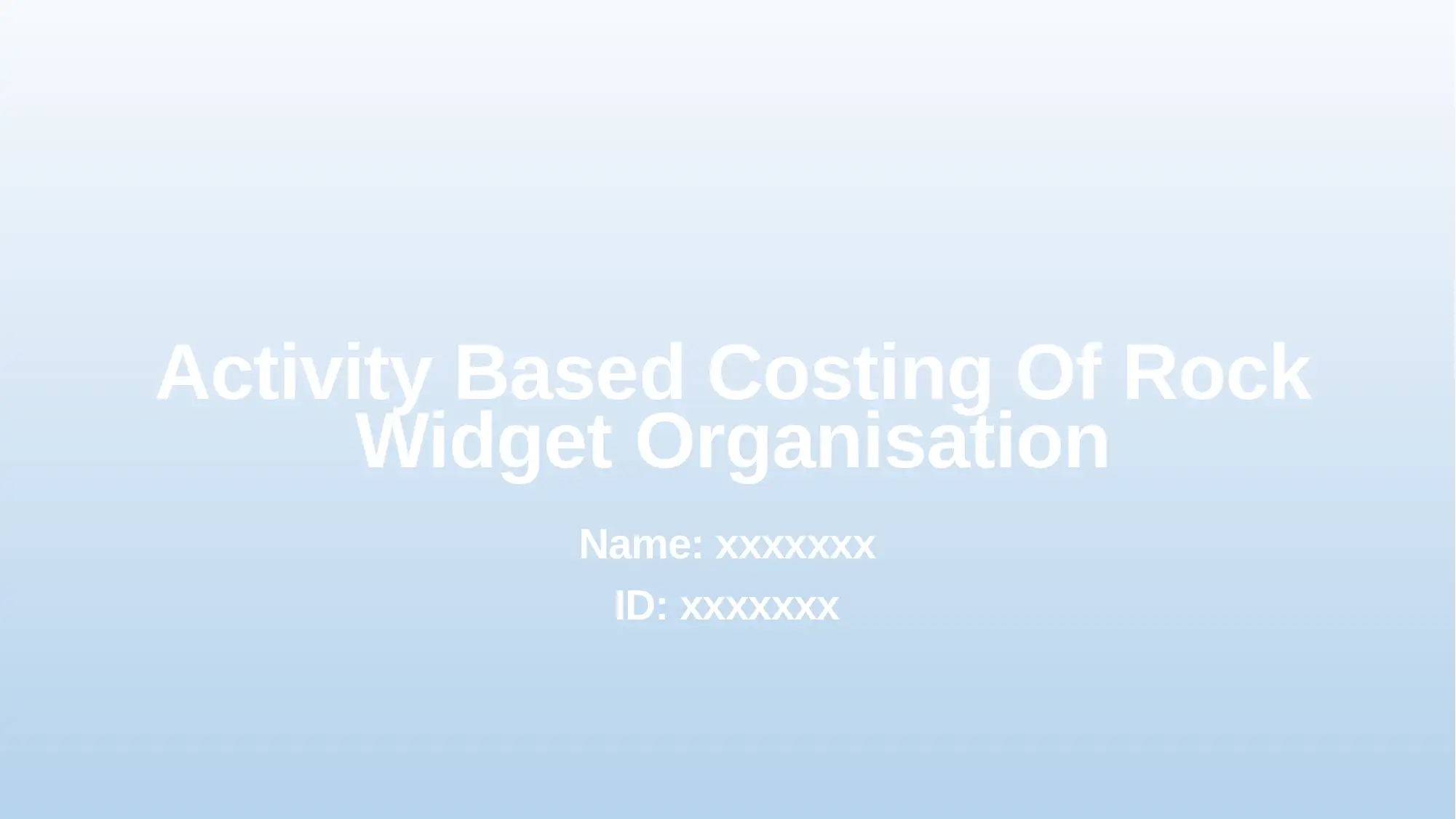
Activity Based Costing Of Rock
Widget Organisation
Name: xxxxxxx
ID: xxxxxxx
Widget Organisation
Name: xxxxxxx
ID: xxxxxxx
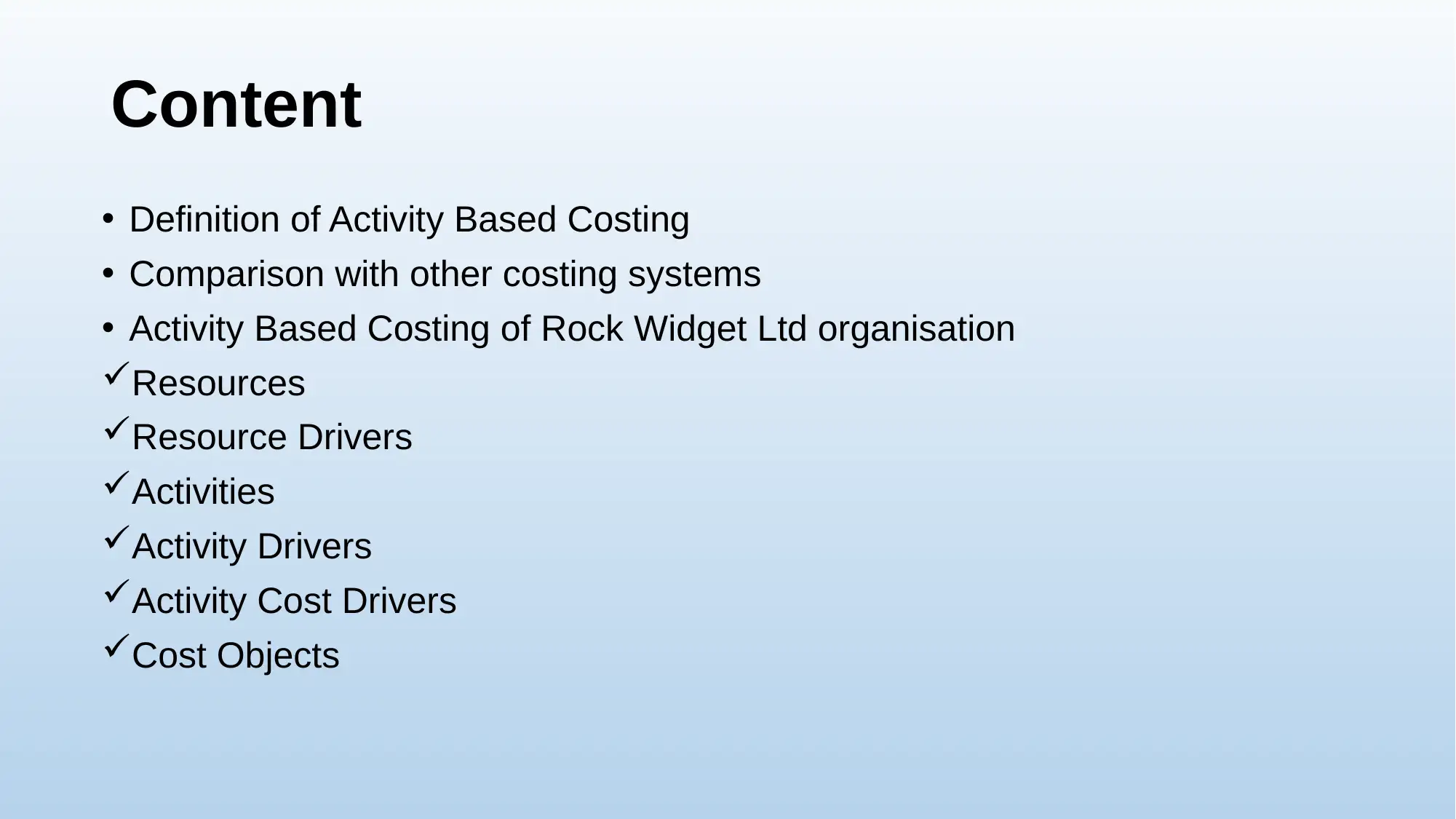
Content
• Definition of Activity Based Costing
• Comparison with other costing systems
• Activity Based Costing of Rock Widget Ltd organisation
Resources
Resource Drivers
Activities
Activity Drivers
Activity Cost Drivers
Cost Objects
• Definition of Activity Based Costing
• Comparison with other costing systems
• Activity Based Costing of Rock Widget Ltd organisation
Resources
Resource Drivers
Activities
Activity Drivers
Activity Cost Drivers
Cost Objects
⊘ This is a preview!⊘
Do you want full access?
Subscribe today to unlock all pages.

Trusted by 1+ million students worldwide
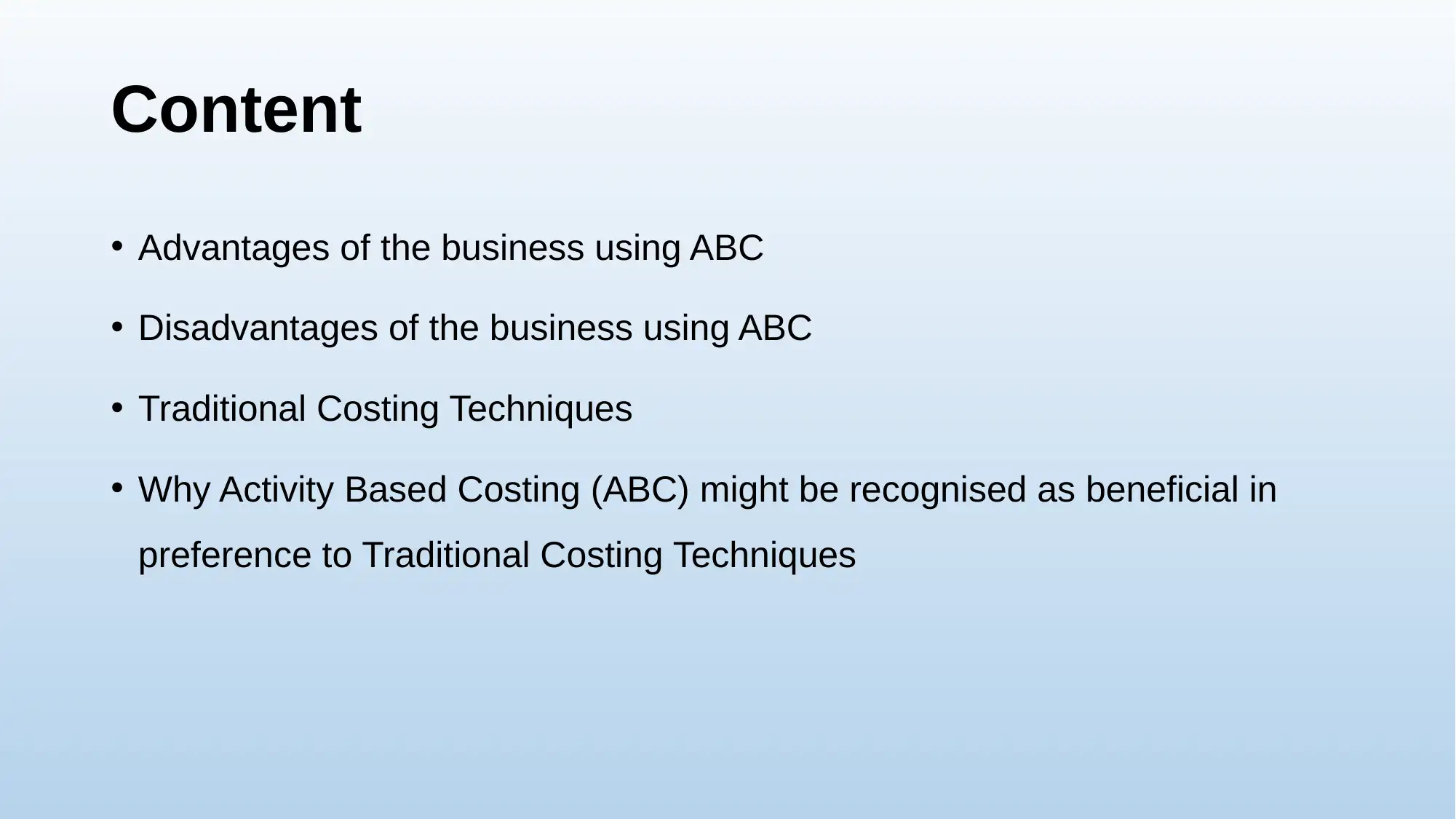
Content
• Advantages of the business using ABC
• Disadvantages of the business using ABC
• Traditional Costing Techniques
• Why Activity Based Costing (ABC) might be recognised as beneficial in
preference to Traditional Costing Techniques
• Advantages of the business using ABC
• Disadvantages of the business using ABC
• Traditional Costing Techniques
• Why Activity Based Costing (ABC) might be recognised as beneficial in
preference to Traditional Costing Techniques
Paraphrase This Document
Need a fresh take? Get an instant paraphrase of this document with our AI Paraphraser
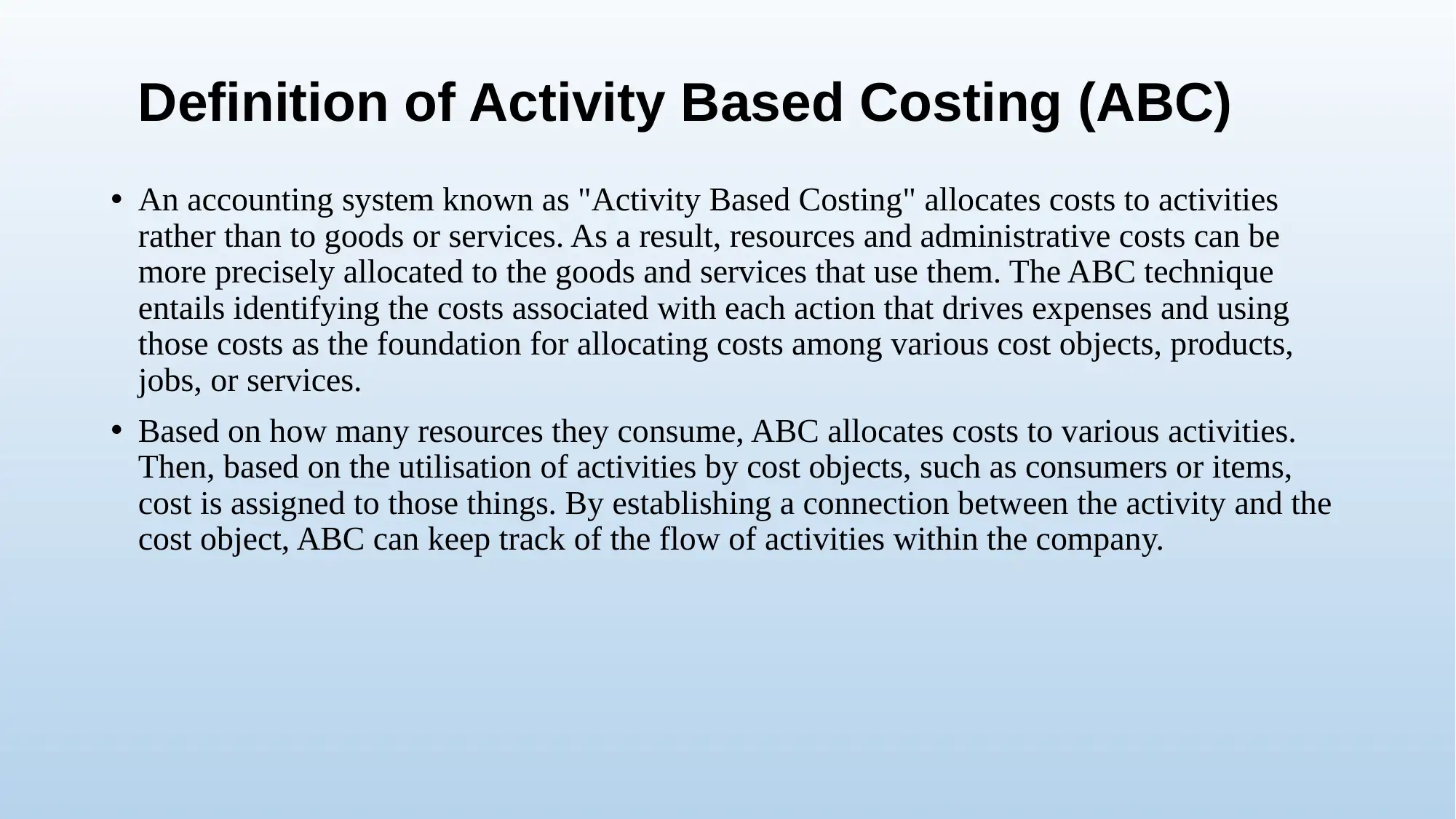
Definition of Activity Based Costing (ABC)
• An accounting system known as "Activity Based Costing" allocates costs to activities
rather than to goods or services. As a result, resources and administrative costs can be
more precisely allocated to the goods and services that use them. The ABC technique
entails identifying the costs associated with each action that drives expenses and using
those costs as the foundation for allocating costs among various cost objects, products,
jobs, or services.
• Based on how many resources they consume, ABC allocates costs to various activities.
Then, based on the utilisation of activities by cost objects, such as consumers or items,
cost is assigned to those things. By establishing a connection between the activity and the
cost object, ABC can keep track of the flow of activities within the company.
• An accounting system known as "Activity Based Costing" allocates costs to activities
rather than to goods or services. As a result, resources and administrative costs can be
more precisely allocated to the goods and services that use them. The ABC technique
entails identifying the costs associated with each action that drives expenses and using
those costs as the foundation for allocating costs among various cost objects, products,
jobs, or services.
• Based on how many resources they consume, ABC allocates costs to various activities.
Then, based on the utilisation of activities by cost objects, such as consumers or items,
cost is assigned to those things. By establishing a connection between the activity and the
cost object, ABC can keep track of the flow of activities within the company.
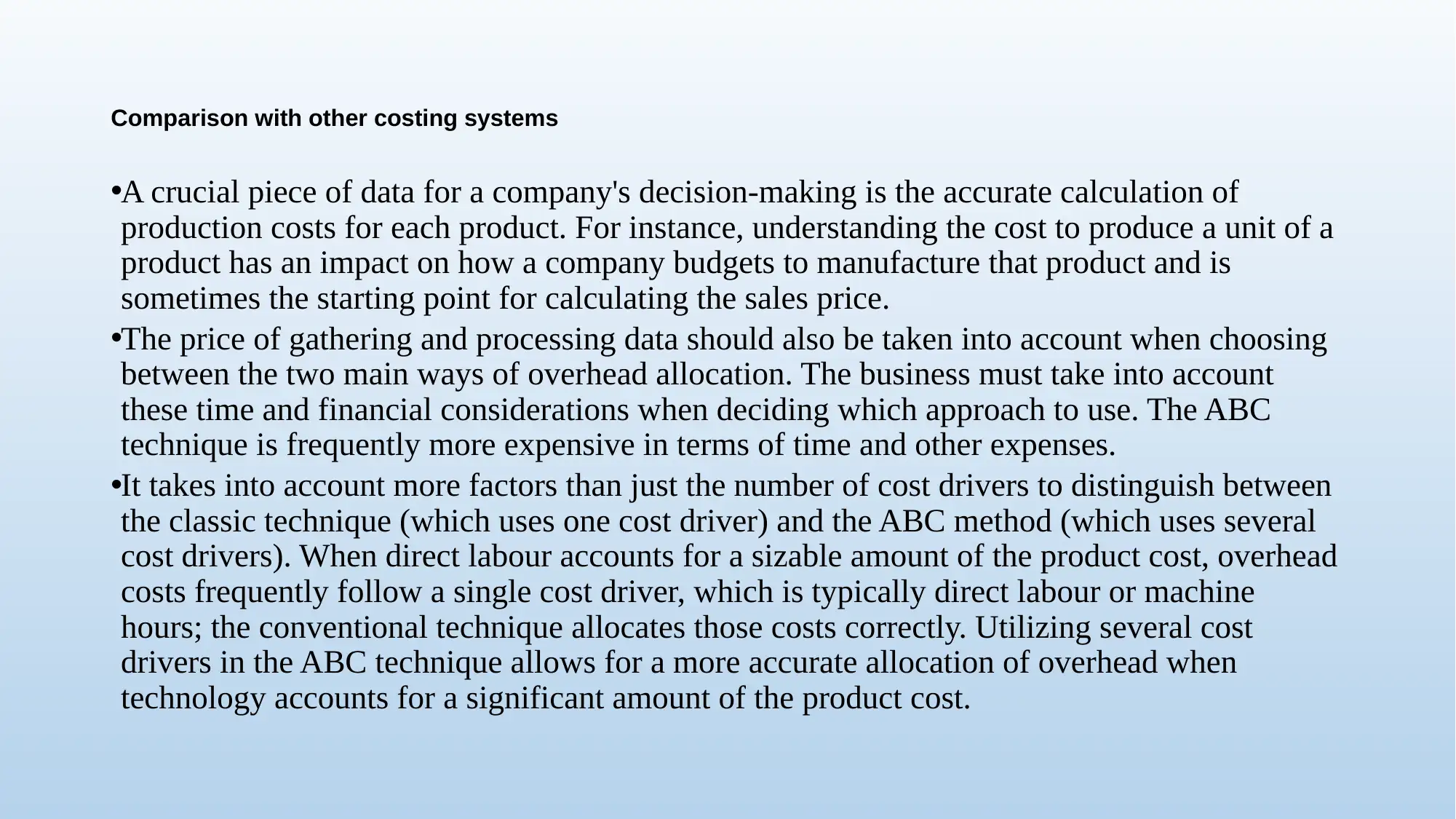
Comparison with other costing systems
•A crucial piece of data for a company's decision-making is the accurate calculation of
production costs for each product. For instance, understanding the cost to produce a unit of a
product has an impact on how a company budgets to manufacture that product and is
sometimes the starting point for calculating the sales price.
•The price of gathering and processing data should also be taken into account when choosing
between the two main ways of overhead allocation. The business must take into account
these time and financial considerations when deciding which approach to use. The ABC
technique is frequently more expensive in terms of time and other expenses.
•It takes into account more factors than just the number of cost drivers to distinguish between
the classic technique (which uses one cost driver) and the ABC method (which uses several
cost drivers). When direct labour accounts for a sizable amount of the product cost, overhead
costs frequently follow a single cost driver, which is typically direct labour or machine
hours; the conventional technique allocates those costs correctly. Utilizing several cost
drivers in the ABC technique allows for a more accurate allocation of overhead when
technology accounts for a significant amount of the product cost.
•A crucial piece of data for a company's decision-making is the accurate calculation of
production costs for each product. For instance, understanding the cost to produce a unit of a
product has an impact on how a company budgets to manufacture that product and is
sometimes the starting point for calculating the sales price.
•The price of gathering and processing data should also be taken into account when choosing
between the two main ways of overhead allocation. The business must take into account
these time and financial considerations when deciding which approach to use. The ABC
technique is frequently more expensive in terms of time and other expenses.
•It takes into account more factors than just the number of cost drivers to distinguish between
the classic technique (which uses one cost driver) and the ABC method (which uses several
cost drivers). When direct labour accounts for a sizable amount of the product cost, overhead
costs frequently follow a single cost driver, which is typically direct labour or machine
hours; the conventional technique allocates those costs correctly. Utilizing several cost
drivers in the ABC technique allows for a more accurate allocation of overhead when
technology accounts for a significant amount of the product cost.
⊘ This is a preview!⊘
Do you want full access?
Subscribe today to unlock all pages.

Trusted by 1+ million students worldwide
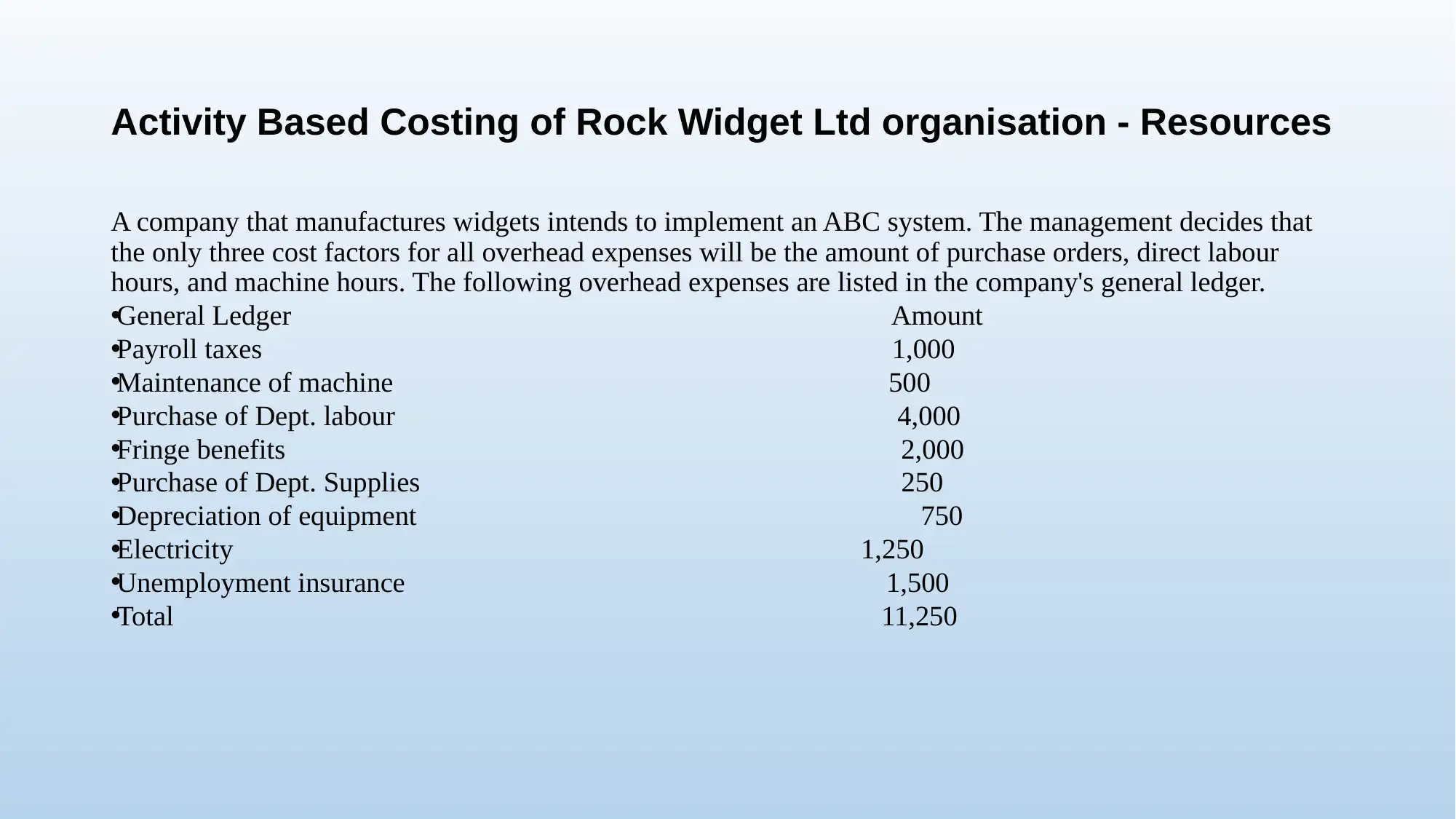
Activity Based Costing of Rock Widget Ltd organisation - Resources
A company that manufactures widgets intends to implement an ABC system. The management decides that
the only three cost factors for all overhead expenses will be the amount of purchase orders, direct labour
hours, and machine hours. The following overhead expenses are listed in the company's general ledger.
•General Ledger Amount
•Payroll taxes 1,000
•Maintenance of machine 500
•Purchase of Dept. labour 4,000
•Fringe benefits 2,000
•Purchase of Dept. Supplies 250
•Depreciation of equipment 750
•Electricity 1,250
•Unemployment insurance 1,500
•Total 11,250
A company that manufactures widgets intends to implement an ABC system. The management decides that
the only three cost factors for all overhead expenses will be the amount of purchase orders, direct labour
hours, and machine hours. The following overhead expenses are listed in the company's general ledger.
•General Ledger Amount
•Payroll taxes 1,000
•Maintenance of machine 500
•Purchase of Dept. labour 4,000
•Fringe benefits 2,000
•Purchase of Dept. Supplies 250
•Depreciation of equipment 750
•Electricity 1,250
•Unemployment insurance 1,500
•Total 11,250
Paraphrase This Document
Need a fresh take? Get an instant paraphrase of this document with our AI Paraphraser
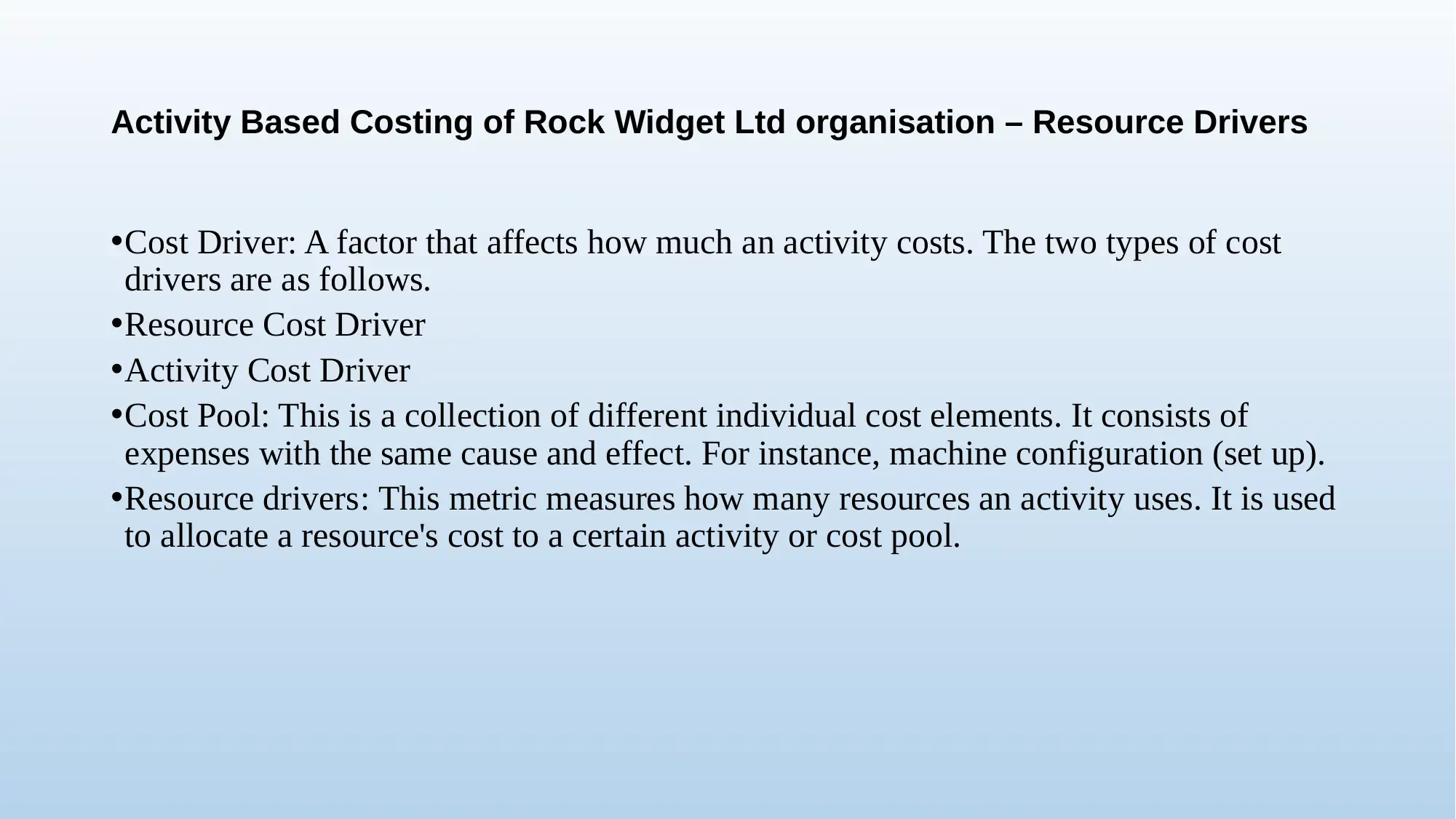
Activity Based Costing of Rock Widget Ltd organisation – Resource Drivers
•Cost Driver: A factor that affects how much an activity costs. The two types of cost
drivers are as follows.
•Resource Cost Driver
•Activity Cost Driver
•Cost Pool: This is a collection of different individual cost elements. It consists of
expenses with the same cause and effect. For instance, machine configuration (set up).
•Resource drivers: This metric measures how many resources an activity uses. It is used
to allocate a resource's cost to a certain activity or cost pool.
•Cost Driver: A factor that affects how much an activity costs. The two types of cost
drivers are as follows.
•Resource Cost Driver
•Activity Cost Driver
•Cost Pool: This is a collection of different individual cost elements. It consists of
expenses with the same cause and effect. For instance, machine configuration (set up).
•Resource drivers: This metric measures how many resources an activity uses. It is used
to allocate a resource's cost to a certain activity or cost pool.
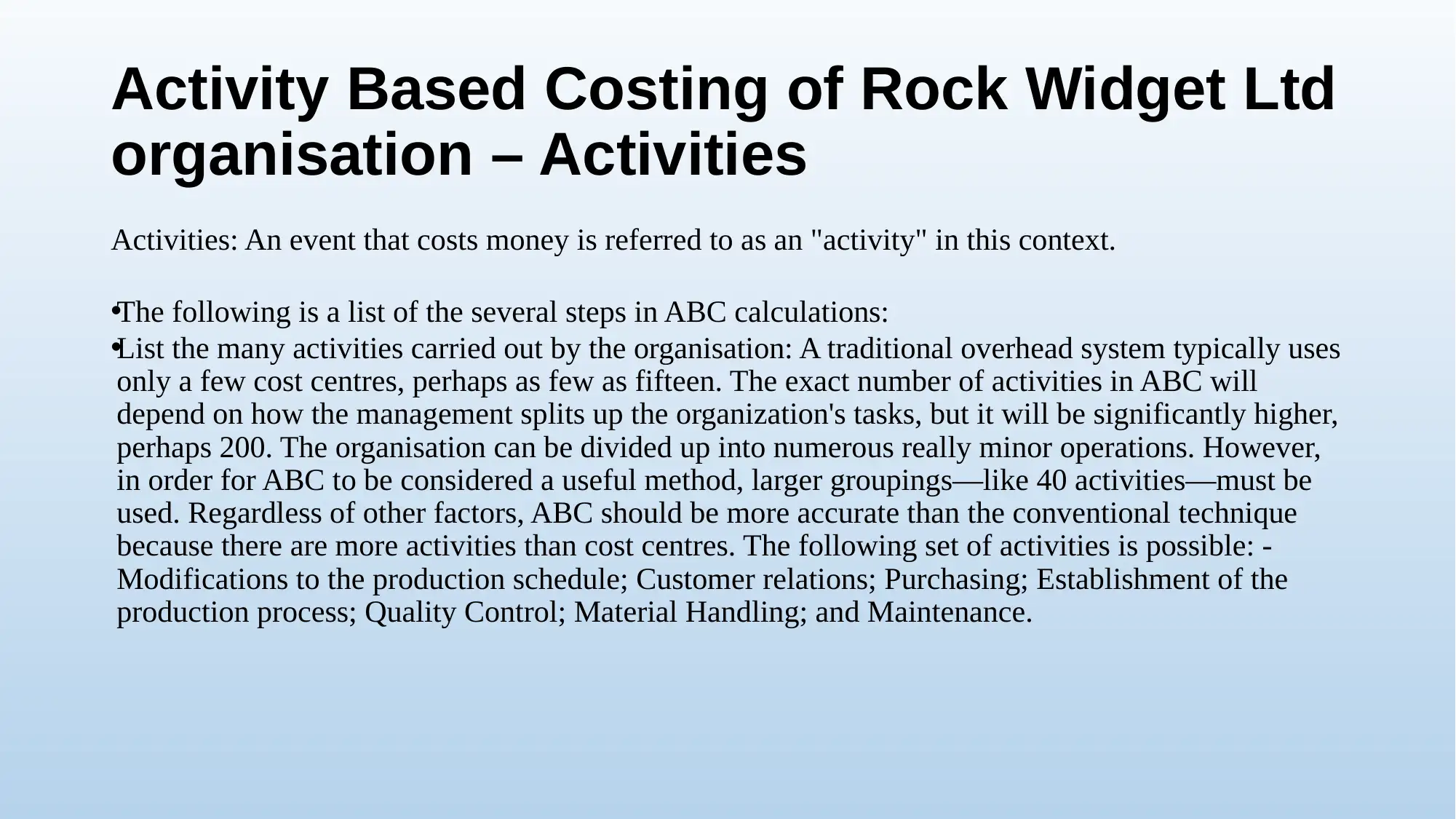
Activity Based Costing of Rock Widget Ltd
organisation – Activities
Activities: An event that costs money is referred to as an "activity" in this context.
•The following is a list of the several steps in ABC calculations:
•List the many activities carried out by the organisation: A traditional overhead system typically uses
only a few cost centres, perhaps as few as fifteen. The exact number of activities in ABC will
depend on how the management splits up the organization's tasks, but it will be significantly higher,
perhaps 200. The organisation can be divided up into numerous really minor operations. However,
in order for ABC to be considered a useful method, larger groupings—like 40 activities—must be
used. Regardless of other factors, ABC should be more accurate than the conventional technique
because there are more activities than cost centres. The following set of activities is possible: -
Modifications to the production schedule; Customer relations; Purchasing; Establishment of the
production process; Quality Control; Material Handling; and Maintenance.
organisation – Activities
Activities: An event that costs money is referred to as an "activity" in this context.
•The following is a list of the several steps in ABC calculations:
•List the many activities carried out by the organisation: A traditional overhead system typically uses
only a few cost centres, perhaps as few as fifteen. The exact number of activities in ABC will
depend on how the management splits up the organization's tasks, but it will be significantly higher,
perhaps 200. The organisation can be divided up into numerous really minor operations. However,
in order for ABC to be considered a useful method, larger groupings—like 40 activities—must be
used. Regardless of other factors, ABC should be more accurate than the conventional technique
because there are more activities than cost centres. The following set of activities is possible: -
Modifications to the production schedule; Customer relations; Purchasing; Establishment of the
production process; Quality Control; Material Handling; and Maintenance.
⊘ This is a preview!⊘
Do you want full access?
Subscribe today to unlock all pages.

Trusted by 1+ million students worldwide
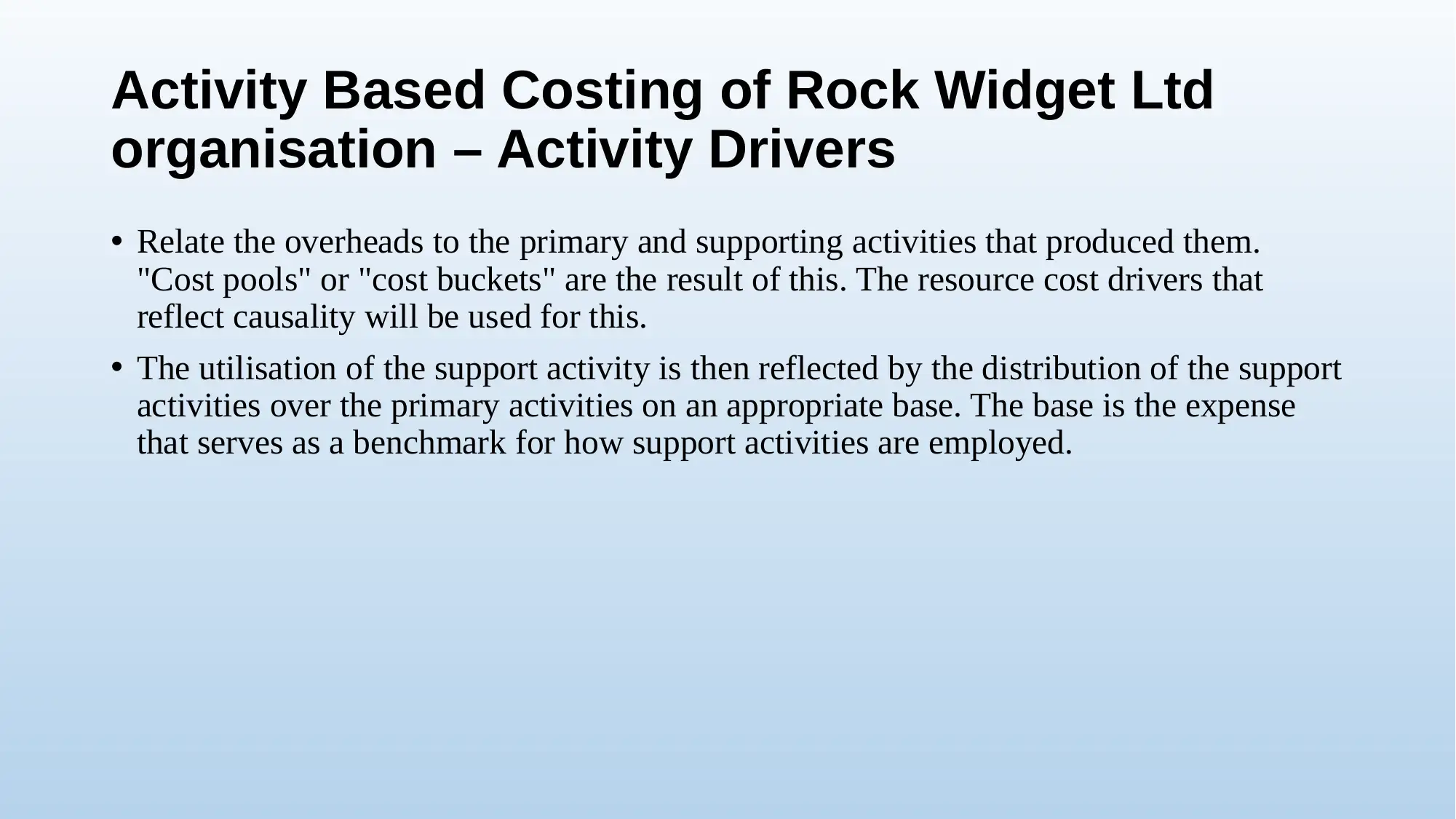
Activity Based Costing of Rock Widget Ltd
organisation – Activity Drivers
• Relate the overheads to the primary and supporting activities that produced them.
"Cost pools" or "cost buckets" are the result of this. The resource cost drivers that
reflect causality will be used for this.
• The utilisation of the support activity is then reflected by the distribution of the support
activities over the primary activities on an appropriate base. The base is the expense
that serves as a benchmark for how support activities are employed.
organisation – Activity Drivers
• Relate the overheads to the primary and supporting activities that produced them.
"Cost pools" or "cost buckets" are the result of this. The resource cost drivers that
reflect causality will be used for this.
• The utilisation of the support activity is then reflected by the distribution of the support
activities over the primary activities on an appropriate base. The base is the expense
that serves as a benchmark for how support activities are employed.
Paraphrase This Document
Need a fresh take? Get an instant paraphrase of this document with our AI Paraphraser
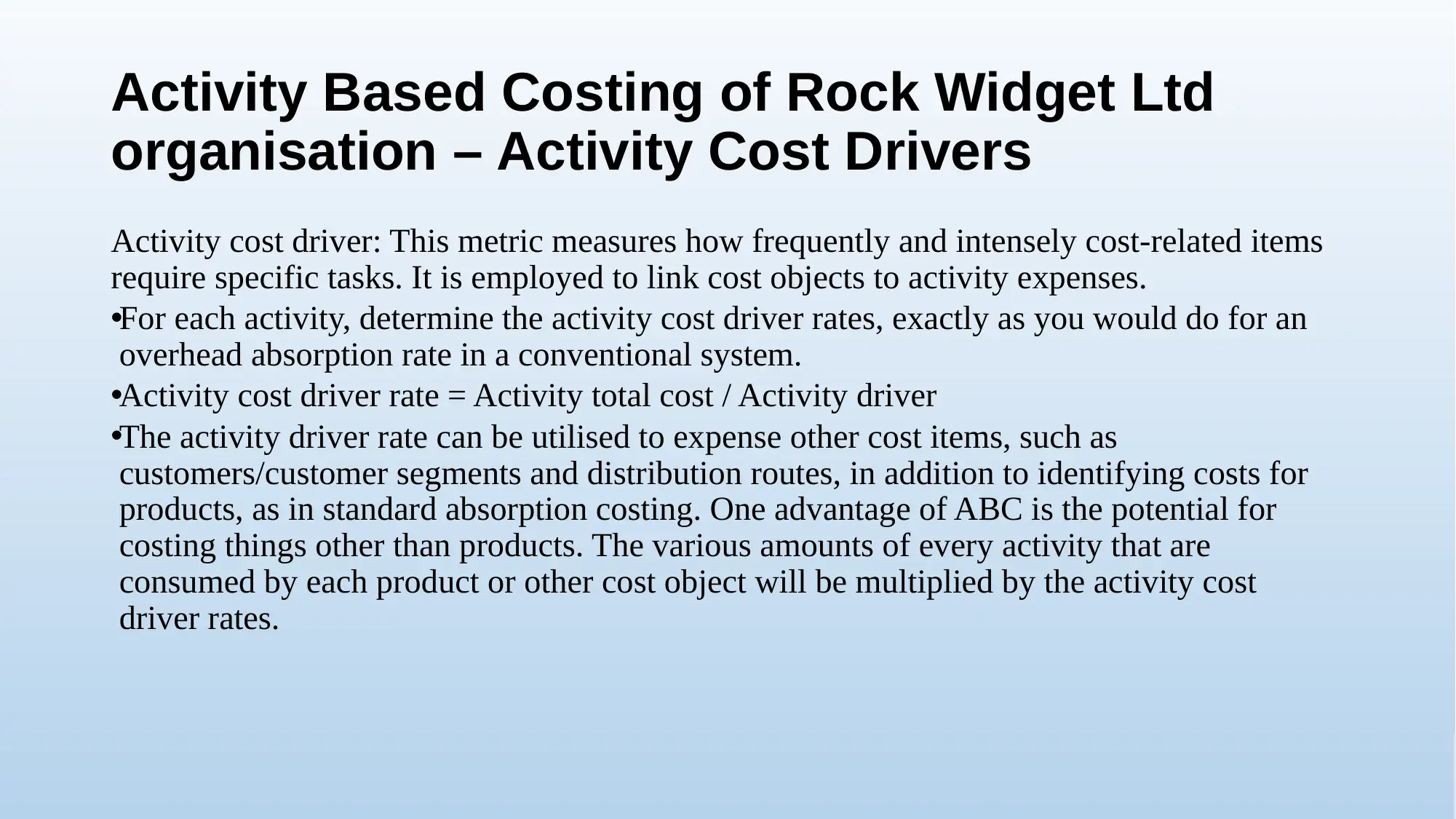
Activity Based Costing of Rock Widget Ltd
organisation – Activity Cost Drivers
Activity cost driver: This metric measures how frequently and intensely cost-related items
require specific tasks. It is employed to link cost objects to activity expenses.
•For each activity, determine the activity cost driver rates, exactly as you would do for an
overhead absorption rate in a conventional system.
•Activity cost driver rate = Activity total cost / Activity driver
•The activity driver rate can be utilised to expense other cost items, such as
customers/customer segments and distribution routes, in addition to identifying costs for
products, as in standard absorption costing. One advantage of ABC is the potential for
costing things other than products. The various amounts of every activity that are
consumed by each product or other cost object will be multiplied by the activity cost
driver rates.
organisation – Activity Cost Drivers
Activity cost driver: This metric measures how frequently and intensely cost-related items
require specific tasks. It is employed to link cost objects to activity expenses.
•For each activity, determine the activity cost driver rates, exactly as you would do for an
overhead absorption rate in a conventional system.
•Activity cost driver rate = Activity total cost / Activity driver
•The activity driver rate can be utilised to expense other cost items, such as
customers/customer segments and distribution routes, in addition to identifying costs for
products, as in standard absorption costing. One advantage of ABC is the potential for
costing things other than products. The various amounts of every activity that are
consumed by each product or other cost object will be multiplied by the activity cost
driver rates.
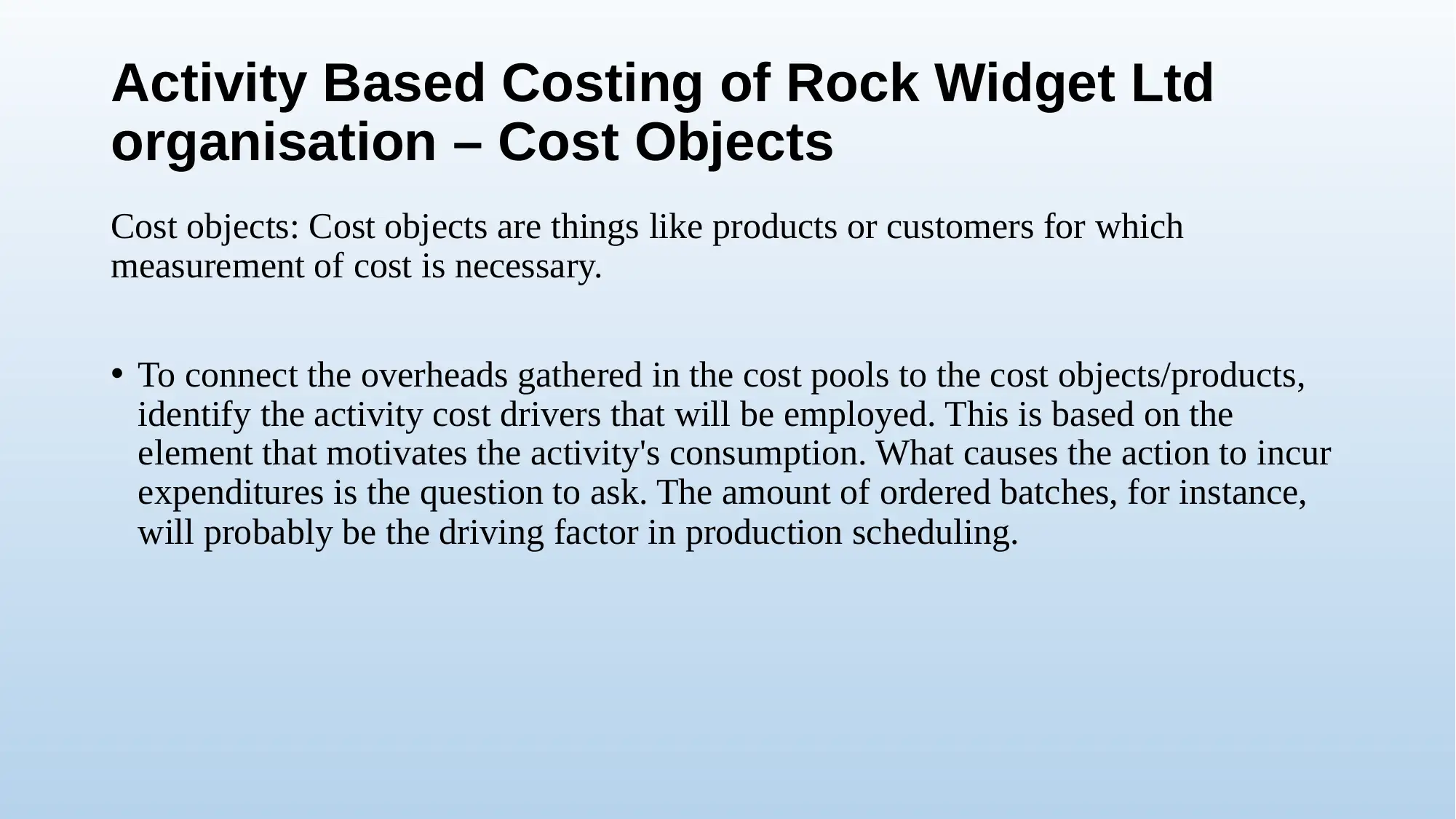
Activity Based Costing of Rock Widget Ltd
organisation – Cost Objects
Cost objects: Cost objects are things like products or customers for which
measurement of cost is necessary.
• To connect the overheads gathered in the cost pools to the cost objects/products,
identify the activity cost drivers that will be employed. This is based on the
element that motivates the activity's consumption. What causes the action to incur
expenditures is the question to ask. The amount of ordered batches, for instance,
will probably be the driving factor in production scheduling.
organisation – Cost Objects
Cost objects: Cost objects are things like products or customers for which
measurement of cost is necessary.
• To connect the overheads gathered in the cost pools to the cost objects/products,
identify the activity cost drivers that will be employed. This is based on the
element that motivates the activity's consumption. What causes the action to incur
expenditures is the question to ask. The amount of ordered batches, for instance,
will probably be the driving factor in production scheduling.
⊘ This is a preview!⊘
Do you want full access?
Subscribe today to unlock all pages.

Trusted by 1+ million students worldwide
1 out of 19
Related Documents
Your All-in-One AI-Powered Toolkit for Academic Success.
+13062052269
info@desklib.com
Available 24*7 on WhatsApp / Email
![[object Object]](/_next/static/media/star-bottom.7253800d.svg)
Unlock your academic potential
Copyright © 2020–2025 A2Z Services. All Rights Reserved. Developed and managed by ZUCOL.





